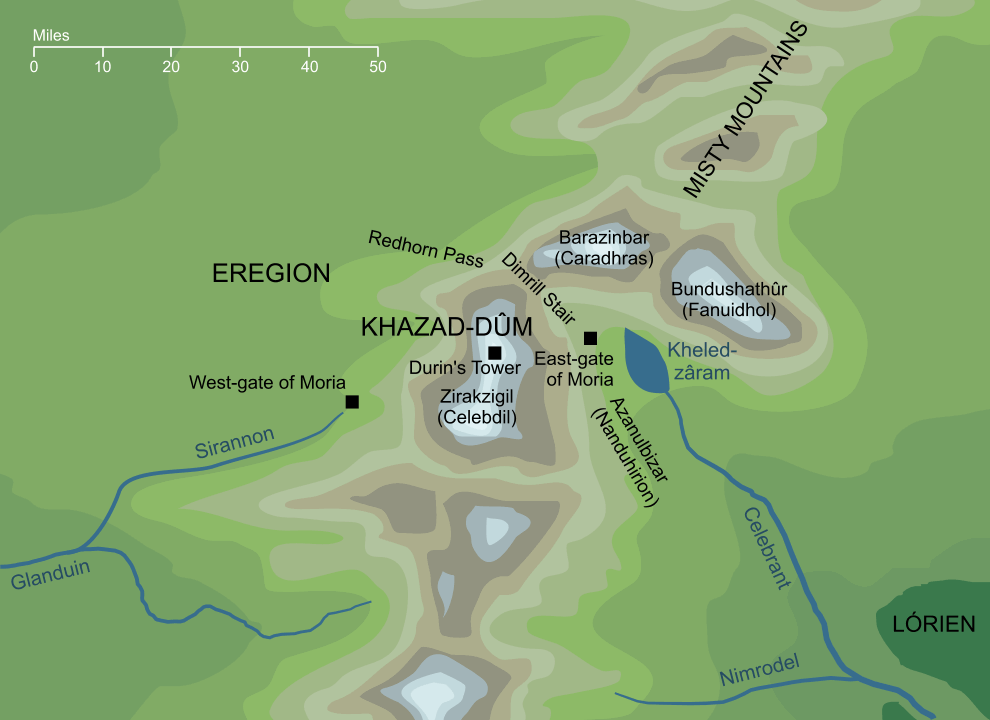- Cities and buildings
- Fields, plains and deserts
- Forests
- Hills and mountains
- Islands and promontories
- Lands, realms and regions
- Rivers and lakes
- Seas and oceans


|
||||||||
|


Which personality type are you?
Take the Free mydiscprofile Personality Test to discover your core personality and your ideal job.   Which personality type are you? |
|
Dates
The date of Khazad-dûm's foundation is uncertain, but it probably predates the first rising of the Sun; deserted in III 1981; briefly recolonised III 2989 - III 2994
Location
In the central regions of the Misty Mountains, to the northwest of Lórien
Origins
Founded by Durin the Deathless
Race
Division
Culture
Family
Ruled by the House of Durin
Important peaks
Passes
The Dimrill Stair led through the Mountains of Moria and down into the valley of Azanulbizar (the Dimrill Dale)
Pronunciation
Probably kha'zad doo'm1
Meaning
Said to mean 'Dwarf-mansions'
Other names
Indexes: About this entry:
|
Khazad-dûmThe mansions of Durin and his kin
The geography of Khazad-dûm2
The geography of Khazad-dûm2
The grandest and most famous of the mansions of the Dwarves. It lay in the central parts of the Misty Mountains, tunnelled and carved through the living rock of the mountains themselves, so that a traveller could pass through it from the one side of the range to the other. It was founded in very ancient days by Durin the Deathless, who came upon a shimmering lake beneath the mountain Celebdil, with a crown of stars reflected in its waters. He named that lake in the Dwarvish tongue, Kheled-zâram, the Mirrormere, and there he started the making of Khazad-dûm. As the millennia passed, the descendants of Durin sat upon the throne of Khazad-dûm, and their cavernous city became famous throughout the world. It even has a passing mention in Quenta Silmarillion, the tale of the Elf-lords and their wars far to the west, though to them it was no more than a distant rumour they heard from the Dwarves of the Blue Mountains on their borders. In the Second Age, Noldor out of Lindon founded a country of their own by the western gates of Khazad-dûm. A rare friendship sprang up between the Dwarves and the Elves of this new land, Eregion. Eregion's ruler, Celebrimbor, lent his skill to the making of the famous and magical gate that became known as the West-gate of Moria, and indeed went so far as to present King Durin III with a Ring of Power. The friendship of Khazad-dûm and Eregion came to a sudden end, though, in II 1697, when Sauron overran the country of the Elves, and the doors of Khazad-dûm were sealed against his forces. Eventually, Sauron was driven back and Khazad-dûm continued to thrive. Much of its great wealth was based on the mithril that was found in its mines, and as the centuries passed, the Dwarves mined deeper and deeper for the precious metal. In the year III 1980, they dug too deep, and unleashed a nameless terror from the depths beneath the city. The creature wreaked dreadful destruction, and in slaying the then King, Durin VI, became known as Durin's Bane. In the following year, Durin's son, Náin I, was also lost, and the Dwarves fled their ancient home. After millennia as one of the richest cities in Middle-earth, Khazad-dûm stood dark and empty, but for the brooding menace the Dwarves had released. In that time it was given a new name, Moria, the Black Pit. The monster of Moria - a Balrog of Morgoth, as was later known - lurked alone in Moria for nearly five hundred years. After that time, the old city of Khazad-dûm began to be populated again, but not by Dwarves. Sauron directed his creatures there, and it began to fill with Orcs and Trolls. Though the Orcs' numbers were greatly reduced in the Battle of Nanduhirion, fought in the valley beneath Moria's East-gate in III 2799, the Balrog could not be bested, and Khazad-dûm remained a citadel of darkness. There were two attempts by the Dwarves of Durin's line to reclaim their ancient home. The first of these was by Balin, who led a force of Dwarves there from Erebor in III 2989, but though he was successful at first, he was eventually defeated and slain. The story of the second attempt to recolonise the Dwarf-mansions is less clear,3 but it seems that after several centuries, Durin VII became King of Durin's Folk, and led a further return to the citadel. He was apparently successful, so that long after the War of the Ring, the Dwarves of Durin's line reclaimed their inheritance, and the hammers rang again in their great halls beneath the Misty Mountains. Notes
See also...Angerthas Moria, Azanulbizar, Azog, Balrogs, Barazinbar, Black Chasm, Black Pit, Book of Mazarbul, Bridge of Khazad-dûm, Bundushathûr, Celebdil, Chamber of Mazarbul, Chamber of Records, Company of the Ring, Crown of Durin, [See the full list...] Indexes: About this entry:
For acknowledgements and references, see the Disclaimer & Bibliography page. Original content © copyright Mark Fisher 1997-2000, 2002, 2008. All rights reserved. For conditions of reuse, see the Site FAQ. Website services kindly sponsored by Discus from Axiom Software Ltd.Discover how DISC fits together with our FREE and comprehensive Complete Introduction to DISC. |